History of the Wood badge
History of the Wood badge
Since September 1919 adult volunteers in the Scouts have been awarded the Wood Badge on the completion of their leader training. The basic badge is made up of two wooden beads worn at the end of a leather lace. This iconic symbol of Scouting has become shrouded in myths and its origins and development confused. Having completed extensive research using the Scouts (UK) heritage collection we have pieced together the story.
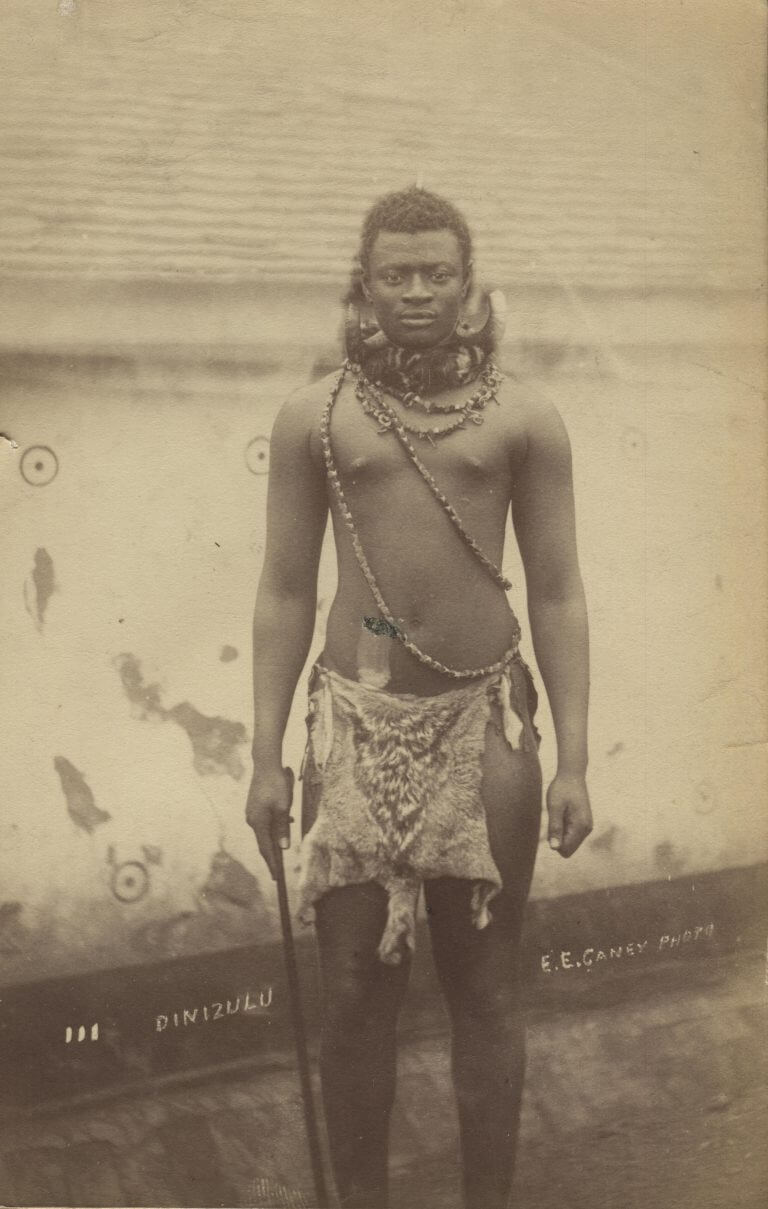
The Components of the Wood Badge
The Wood Badge’s design took inspiration from a necklace brought back from Africa by Scouting’s Founder, Robert Baden-Powell. In 1888 Baden-Powell was serving with the British Army in Africa. During this period Baden-Powell visited an abandoned camp where Chief Dinizulu, a local chief had been based.
In 1925 Baden-Powell recalled what he found: ’In the hut, which had been put up for Dinizulu to live in, I found among other things his necklace of wooden beads. I had in my possession a photograph of him taken a few months beforehand in which he was shown wearing this necklace round his neck and one shoulder.'
Assuming the necklace was the same one as in the photo Baden-Powell took the necklace as a souvenir of the campaign and always referred to it as Dinizulu’s necklace. Baden-Powell admired Dinizulu describing him as “full of resources, energy and pluck,” characteristics which he would later call upon Scouts to develop.
The necklace was not the only souvenir of his military career which would come to be important to Scouting. In 1900 Baden-Powell was the British Army Commander during the Siege of Mafeking (2nd Boer War, South Africa). During the siege he had a conversation with an elderly African gentleman. He presented Baden-Powell with a leather lace which he wore around his neck saying his mother had given it to him for luck and now he would pass that gift on to Baden-Powell.
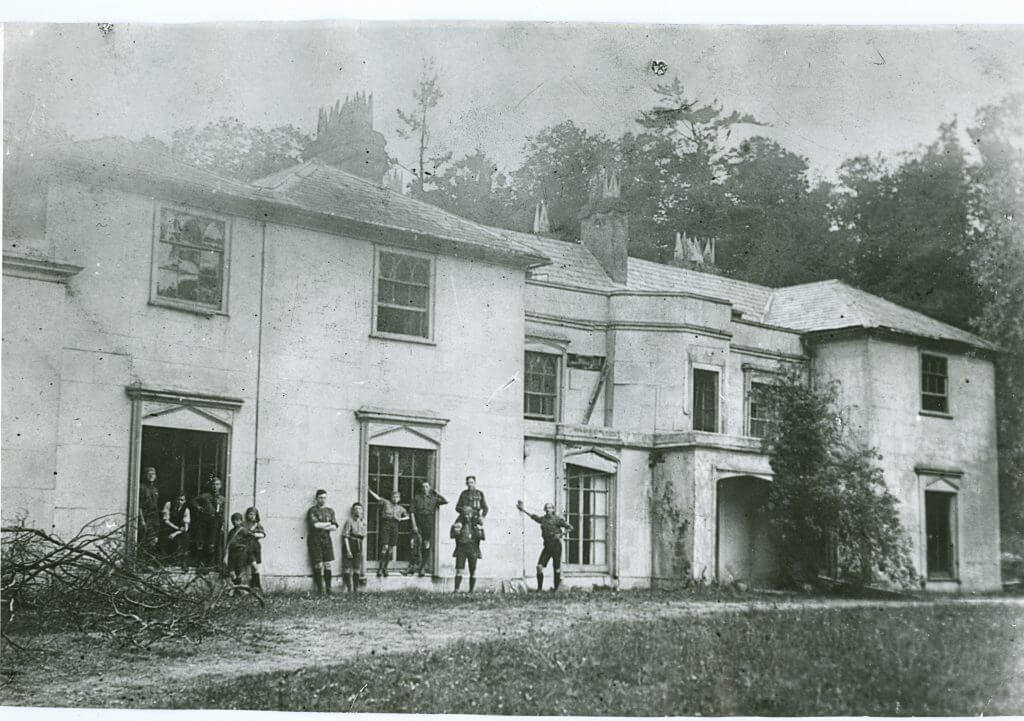
The Need for Scout Leader Training
Following the First World War there was a great need to establish a leader training programme for UK Scouting. At least 5,000 older Scouts and adult volunteers had been killed during the conflict but youth section membership had grown by over 46,000. This created a need to train and develop new leaders, ensuring the future of the Movement.
The ideal opportunity arose when in November 1918 benefactor, William de Bois Maclaren, generously offered to buy a camping area for inner city London Scouts who lacked access to suitable grounds. Gilwell Park, on the edge of Epping Forest, was found and purchased. The site was big enough to offer camping facilities for Scouts as well as hosting a training centre for leaders.
The Wood Badge course wasn’t the first ever training course for leaders. Events had been held prior to the First World War and local areas had set up their own arrangements. In early 1919 East London Commissioner Percy Bantock Nevill arranged a correspondence course for leaders covering theoretical and administrative topics. He was in the process of organising a camp to cover more practical skills when he found out about the purchase of Gilwell Park. He rearranged the camp to take advantage of this new facility and held the practical training course on the 18-19 May 1919. This was the very first training offer at Gilwell Park.
The idea from Scout Headquarters was to create a training syllabus for leaders to ensure a standard, quality and consistency for training. A date was set for a pilot course to be held at Gilwell Park from the 8 – 19 September 1919.
In August 1919 Baden-Powell contacted Percy Everett, who was developing the course alongside Camp Chief Francis Gidney, seeking his opinion on how to acknowledge the achievement of leaders who had completed their training. 'Scoutmasters who pass through Gilwell Park should have some form of badge to wear. He suggests a Tassel with ornamented ends to be worn in the hat.'
This issue had not been concluded by the time the course was running. On 15 September 1919 Eileen Nugent (Baden-Powell’s secretary) wrote to Percy Everett saying: 'The Chief Scout has suggested to Capt. Gidney the following decoration for Scoutmasters passing the training course, in place of the cords around the hat a bead at the end of the lacing of the hat in three grades:
- Wood
- Bronze
- White metal
He has asked Capt. Gidney to go ahead in getting some beads made (like those of the Chief’s which you have) ready for award at the end of the course.'
We can only assume the beads referred to in this note are the ones from the necklace Baden-Powell had collected in South Africa over 40 years previously.
The training course was organised to give the participants a sense of what it was like to be a member of a Scout Troop. They took on the role of Scouts, they were formed into patrols and rotated the role of Patrol Leader and Seconder. Francis Gidney took on the role of Scoutmaster.
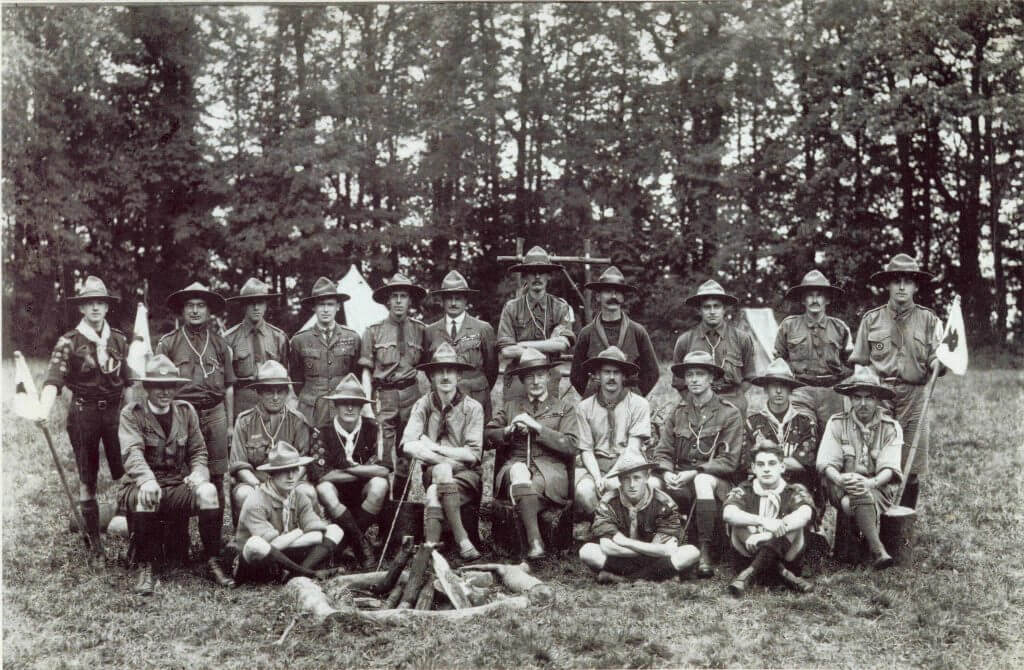
The course syllabus included a range of practical skills such as pioneering, campcraft, games, fieldwork and pathfinding.
They also attended specialist lectures on topics as varied as Industrial Welfare, the Education Act and Rover Scouting. The course ended with a visit to Headquarters on Buckingham Palace Road in London and a lunch meeting with Baden-Powell.
The Rev. Charles Hines attended the pilot course. He later recalled how he received his wood badge created by Baden-Powell using one of the beads from 'Dinizulu’s necklace'.
Hines wrote: 'This historic necklace consisted of small hornbeam beads, shaped like miniature double edged axe heads, tightly threaded, criss-cross, on a leather thong which was as stiff as a backbone.
'Taking one of these beads and a replica made from Epping Hornbeam B-P threaded them on a short leather lace, tied to a brass curtain hook, pinned it on my lapel and announced that he had decided to make it the official award for efficiency in Woodcraft and camp management – and to be known as the Dinizulu Woodcraft badge.
'He then presented to each of my brother officers one of the original beads together with a small piece of Epping Hornbeam from which to shape a duplicate and assemble their badge.'
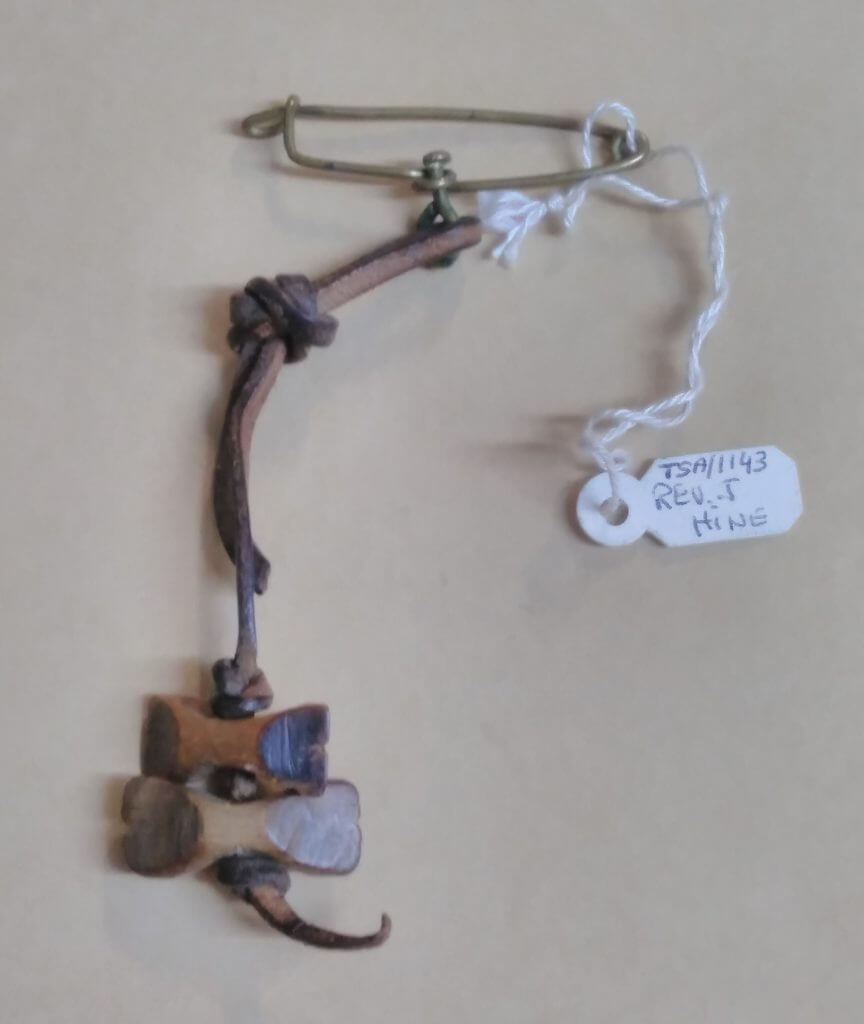
Developing the training offer
The pilot Wood Badge course had been a success but it was clear that not all leaders would be able to give 10 days to attend such a course. On 17 October 1919 Baden-Powell wrote to Francis Gidney to discuss what they had learnt from the pilot course. He referenced Percy Nevill’s concept of delivering theoretical and administrative training through a correspondence course suggesting this could be completed over the winter months and the practical training residential carried out over the summer.
He also discussed the developing design for a Wood Badge. 'After passing the theoretical and practical course satisfactorily the candidate would be entitled to wear one wooden bead on the buttonhole.
After passing all three satisfactorily, on bead on the hat string and a Diploma.
If he shows special capability and ability for training others as a local Camp or Circle Chief, he could wear the double bead on a hat string.'
Baden-Powell even produced a sketch on a Headquarters postcard of how various badges could look.
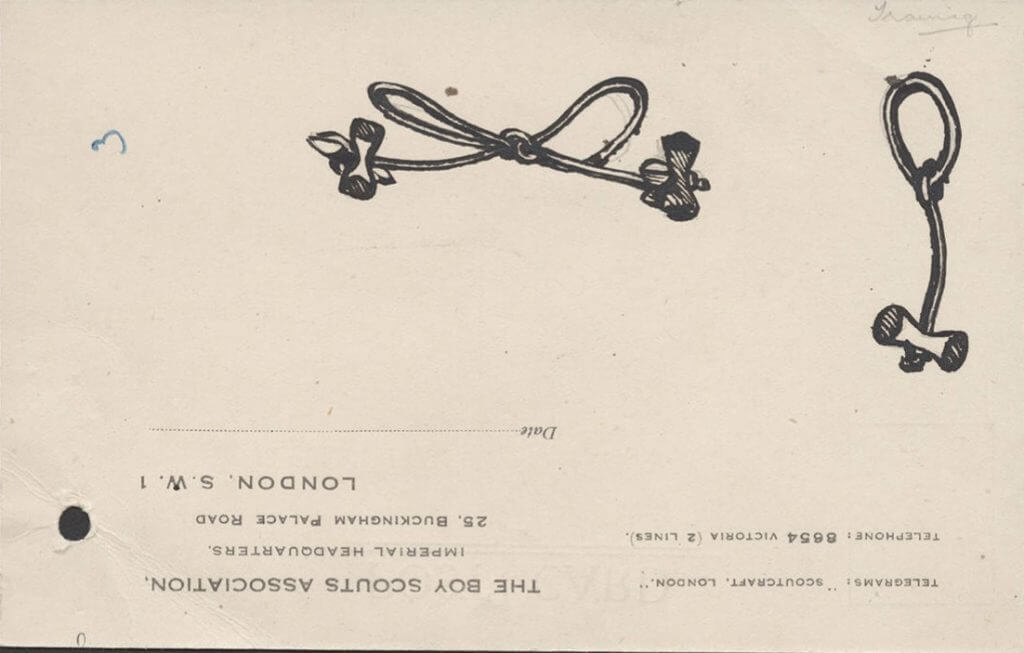
By November 1919 this new structure had been agreed and was announced in the Headquarters Gazette.
The design of the Wood Badge continued to evolve. In 1921 the first description of the wood badge in POR (Policy, Organisation and Rules) doesn’t mention the different badges or it being worn around the hat. It describes the badge as being 'worn strung on a leather bootlace round the neck'.
Deputy Camp Chiefs were to be allowed to wear a set of four beads. Around this time the only two set of six wood beads were created and were worn by Baden-Powell and Percy Everett.
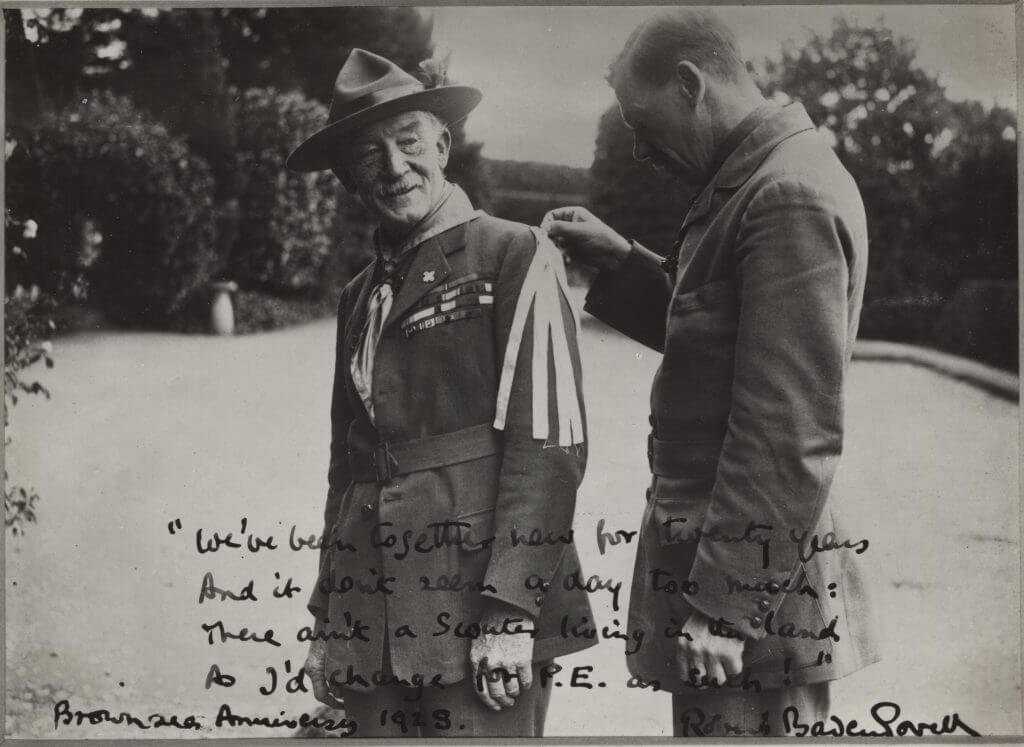
All six beads on both necklaces come from 'Dinizulu’s necklace'. In 1949 Everett made it known that he would present his set to John Thurman, Camp Chief at Gilwell Park and that they should be passed down to his successors in that role. This continued until 2015 when it was decided to retire this set of beads due to their historical importance. Both sets of six beads are held in the Scouts (UK) heritage collection. At Gilwell Park the role of Camp Chief is now an honorary title held by the Chief Operating Officer.
The beads from the original Zulu necklace quickly ran out and Scout leaders who left the Movement were asked to return their Wood Badges so they could be recycled.
At some point in the early 1920s Haydn Dimmock, editor of The Scout magazine, sourced an alternative necklace: 'Mention of Portobello Road reminds me that it was there, on a stall literally crowded with junk and so-called antiques, that I discovered a genuine Zulu necklace similar to that which the Chief Scout had secured from Donizuli (sic) the Zulu Chief, the wooden beads from which historic necklace were used for the original wood badges given to Scouts passing the Wood Badge course of training.'
These beads were used for a while to supplement the dwindling supply of 'original' beads.
Cub leader training
In 1921, the first training course for Cub Leaders was held. Rather than receiving the Wood Badge leaders were presented with a replica wolf fang on a leather lace known as the Akela badge. An Akela leader, who delivered training courses could wear two fangs.
In 1926, it was decided to use the Wood Badge design for both Scout and Cub leaders, although the names would continue to be Akela badge for Cubs and Wood Badge for Scouts. To differentiate between the leaders a coloured bead was added above the wood beads to show which section they belonged to. Yellow beads were used for Cub leaders, green for Scout and in 1927 a red bead was introduced for Rover Scout leaders. This idea proved to be very unpopular and ceased to be used from 1928, at this point the badge became universally known as the Wood Badge.
The Wood Badge Today
The Wood Badge continues to be awarded to adults in Scouting who complete their training. It's awarded to Scouts around the world and all those who achieve their badge automatically become a member of the 1st Gilwell Park Scout Group, the largest in the world.
| 1888 | Baden-Powell acquires a Zulu necklace, believed to have belonged to Chief Dinizulu, which is later used to create the early Wood Badge |
| 1990 | Baden-Powell is presented with a leather lace during the Siege of Mafeking, he later uses this idea to form the Wood Badge. |
| 1919 | Gilwell Park is purchased The pilot Wood Badge course is held First Wood Badges are presented Three stage training course is set |
| 1921 | First Cub leader training course is held First Gilwell Reunion is held Deputy Camp Chief (UK) badge is created with four beads |
| 1924 | Deputy Camp Chief for a country badge is created with five beads |
| 1947 | Introduction of badge for Assistant Deputy Camp Chiefs and Assistant Akela Leaders, three beads. |
| 1950-51 | Percy Everett presents his set of six wood beads to the Camp Chief of Gilwell |
| 1959 | Change in training structure in the UK “Scouters who have passed the Wood Badge Preliminary training course are entitled to wear in uniform the Gilwell woggle consisting of a leather two strand Turkshead. Scouts who have gained the Wood Badge are entitled to wear in uniform the Gilwell scarf and woggle, and the Wood Badge on a leather thong round the neck.” |
| 1987 | Chief Minister Mangosuthu Buthelezi of Kwazulu (the grandson of Chief Dinizulu) attended a Scout rally and was presented with a Wood Badge with four beads by the then Chief Scout of South Africa in a symbolic act of returning the beads to their rightful heir. |
| 1989 | Change in training structure in UK, only award is Wood Badge completion of training. |
| 2003 | Changes to acknowledgement of training progress. Still current 2018. a. On completion of the Getting Started modules, uniformed adults may wear the Gilwell Turks Head woggle. b. For occasions when uniform is not worn, uniformed adults may wear a metal pin badge depicting the Gilwell log and axe. c. On completion of the Getting Started modules non-uniformed adults may wear a metal pin badge depicting the Gilwell log and axe. d. The Award for completion of training for Warranted adults is the Wood Badge e. Leaders holding the Wood Badge may wear the Gilwell Scarf and woggle |